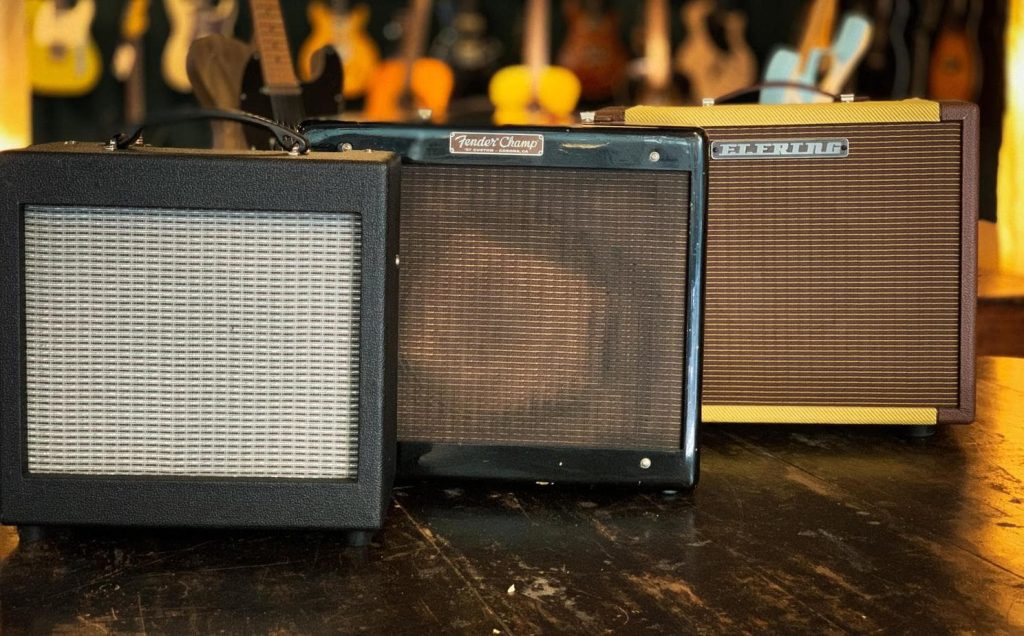How does it sound
Tiny Amp Shoot-out
I’ve been seeing more and more small tube amps come along lately. Small in size, low in wattage and super simple with only one volume and one tone control. What can you actually do with them, I wonder? Spying through the store it appears that we have three examples in the house. A Fender Custom Shop Limited Edition 57 Champ that was just traded in by a customer, a Little Gem by Floris Elfring and a Boston Duane Jr. So there is no lack of material. But first the question; what to do with a Tiny Amp? Or in more positive terms: what can you do with it?
Why
The supply of amps is more diverse than ever. Lots of digital stuff, lots of hybrid options. With the rise of that digital and hybrid amplification, the need to pull open a 50 watt amp beast seems to be partially evaporating. “Vaporized nor mahl,” I hear the purists among you say. Also, the increase in in-ear monitoring and low-volume stages cause the big amps to be seen in a different light. Not entirely justified because there are good solutions for the volume. But more about that soon. But where in the vast array of products do the low watt tiny amps deserve their place? I don’t think power is the determining factor. That goes for a big amp and equally for a small amp. It’s all about tone my friends, just tone.
In terms of sound you can get very far with a small amp. Eric Clapton recorded Layla over a Fender Champ. And Keith Richards and Billy Gibons also used smaller tube amps in the studio. And there, of course, the relatively low volume is very practical. And if you want to play on tubes at home then a Tiny amp is really the only solution that sounds good and leaves your relationship with roommates and neighbors sort of intact. We deliberately say ‘sort of’ because a Tiny amp is not necessarily soft. Certainly if you compare it with the ‘bedroom mode’ of other amps, the tiny amp is still quite a noisemaker. But for those who enjoy unadulterated tube sound, an amp you can open up without artificial volume adjustments, the tiny amp is a super interesting option.
Tiny amps under the microscope
While we have it in the store let’s test it. And so we put the Boston Duane Jr., the Elfring Little Gem and the Fender Custom Shop Champ through their paces. In terms of looks, the Duane Jr. is the simplest of the trio. The small black tolex enclosure and silver-gray speaker cloth is mostly functional and doesn’t immediately give you the feeling that this is going to be an enhancement to your man cave. Too bad, because with a small logo on the speaker cloth it would immediately look much more attractive. The control panel is also austere. The Little Gem makes us happier. A traditional tweed look with brown speaker cloth. This does not look out of place in your living room or studio. The Fender Champ comes from the Custom Shop and there they have spent a considerable amount of the budget on the looks. The amp is black lacquered and ge-aged. As if you played the tweed on it yourself and quickly wielded the brush with black paint in the back of the van. It looks pretty believable. In terms of dimensions, they don’t differ much. The Little Gem is the largest of the three and the Duane Jr. is the smallest.
Under the hood
All three amps seem to have the same inspiration. All have a 6v6 tube in the output stage. The Little Gem and the Duane Jr. make do with a 12AX7 tube in the pre-amp and the Fender has to make do with a 12AY7. The 12AX7 gives the amp a little more drive. Both the Duane Jr. and the Little Gem are equipped with an 8 inch Celestion speaker. The Fender has a 10-inch Celestion Green Back.
The key question; what does it sound like?
We played all three amps both clean and overdriven. Clean, the Duane Jr. sounds quite Princeton-like. But without the enormous amount of low power of the Princeton. If we turn up the gain a bit more it appears that the overdrive is easily adjustable with the volume knob of your guitar or with your right hand. It’s nice to know that even when you turn up the volume the individual notes in a chord remain intact. If we turn the volume knob beyond 10, the Duane collapses slightly. On position 10 you have a beautiful and very dynamic lead sound. From whispering to crying all under your fingertips.
The Fender is cleanly played the most characterful of the bunch. The typical somewhat nasal old Champ sound is abundant. It’s a very carrying sound with lots of overtones that shimmer on for a long time. The Fender has without a doubt the most complex tone of the three. And when we turn it up, a big smile comes to our faces. Everything adds up. It’s an impressive riff machine and the lead tones stand like a house with sustain for days.
The Little Gem is clean very balanced. Nice and defined low end with more headroom than the Duane. The built in spring reverb completes the clean sound. When we turn up the volume the Little Gem appears to be a somewhat different amp than the Fender and the Duane. The amp has a lot of headroom and oversteps considerably less than the other two. This makes it very suitable for pedals.
At the end of the day….
The Duane Jr. surprised us the most. For a good €350,- you can buy an authentic tiny tube-amp that plays above its price range. The Fender is the real thing. Especially with the 10 inch speaker this is a characterful beast of a tiny amp. This does come with a price tag of just over €2000. Of the three, the Elfring Little Gem is best suited for pedals and, with a price of just under €1000 for a hand-built amp in the Netherlands, is still a good deal.
Boss Kauffmann





